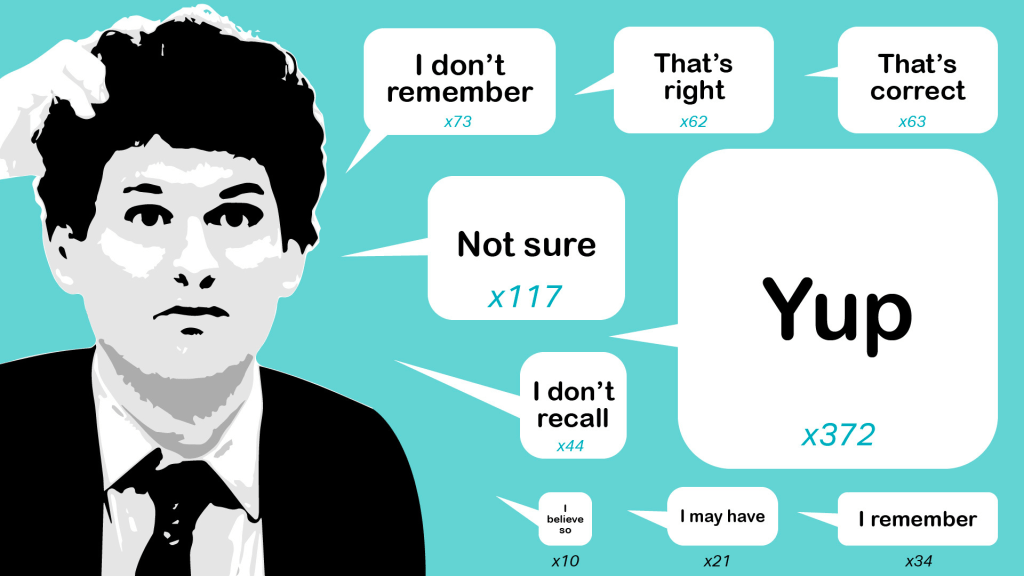 Image Credits: Bryce Durbin / TechCrunch
Image Credits: Bryce Durbin / TechCrunch
On Thursday, a federal judge sentenced former FTX CEO Sam Bankman-Fried to 25 years in prison after he was found guilty on seven charges of wire fraud and money-laundering.
The scam he pulled was fairly simple: He and his partners created an exchange, FTX, that took customer deposits to invest in and trade cryptocurrencies. Some of those deposits were secretly funneled to his other company, hedge fund Alameda Research, which he’d originally created to arbitrage differences among crypto prices in various countries. According to the government’s case, which it won, Alameda used that money for various things it shouldn’t have, like investing in other crypto startups, buying some very nice real estate, supporting political campaigns and — most important for purposes of the scam — propping up FTX’s proprietary crypto token, FTT.
A few document leaks and some clever work by journalists at Coindesk, combined with a well-timed tweet by Changpeng “CZ” Zhao, who ran rival crypto exchange Binance, caused a run on FTX. The scheme unraveled in a matter of days, wiping out billions in customer money (although, apparently, they may get a fair portion of that money back). CZ himself is no longer running Binance, having pleaded guilty to money-laundering violations related to insufficient controls.
The sentencing brings to an end the most recent era of crypto, which was characterized by greater-fool get-rich-quick schemes on the way up — investors were lured in with promises of impossibly high returns on everything from digitally watermarked images to simple interest payments on the token of the week — and fraud investigations and indictments on the way down.
Sam Bankman-Fried gets 25 years in prison for fraud and money laundering at FTX, ordered to pay $11B in forfeiture
Crypto optimists like Andreessen-Horowitz’s Chris Dixon suggest that we’re now entering a more sober phase of crypto, where software developers will finally build useful applications on one of the many blockchains that have emerged since the original blockchain — the one underlying bitcoin — was first proposed by the pseudonymous Satoshi Nakamoto and distributed on Halloween 2008.
The problem with this point of view is that developers have been building a wide variety of applications on top of Ethereum and Solana and other Layer-1 blockchains for years now, and the only economically viable purpose any of them have served is speculation. Yes, it’s possible to create a digitally authenticated piece of art, but the value of that art isn’t in the aesthetic pleasure it brings, but rather in the possibility that somebody else will buy it for more money later.
Nearly everything else that’s being built on or enabled by blockchains replaces something that’s already being done fairly well. Self-executing smart contracts replace — you know, regular contracts. Which aren’t perfect, but aren’t so ridiculously inefficient that they grind the economy to a halt. Decentralized autonomous organizations, or DAOs, where decision-making is shared equally among all participants, replaces other decentralized organizational schemes characterized by hours of debate and few concrete decisions, like holacracy or San Francisco Board of Supervisors’ meetings. Jokes aside, where is the clear killer app for blockchains? Where’s the runaway success story?
Forget runaway success: There hasn’t even been a single blockchain-based startup with enough cashflow or profitability to go public. Yes, there are bitcoin mining companies like Riot. Yes, there are companies that facilitate crypto trades like Coinbase and Block (formerly Square). But there’s no actual company that’s developed economic value by doing something brand new or better on a blockchain.
I’m open to persuasion — pitch me, blockchain geniuses, with incredible value-creating startups! — but my view right now is that crypto will revert to the original function of Bitcoin as an alternative to nation-based currencies for storing and exchanging value. Its volatility may not make sense to people living in relatively stable economies, but in countries with runaway inflation, corrupt governance, civil unrest or war, the method of converting collapsing local currency to bitcoin to stablecoin to a stable national currency like the U.S. dollar will remain a reasonable and in-demand way for people with some means to preserve those means. It’s also useful for sending remittances without having to pay outrageous fees for international money changers, and — sometimes — as a digital replacement for suitcases of cash for all kinds of underground economic activity.
Why bitcoin instead of one of the newer coins? Because those other coins are almost universally based on faith, trust and pixie dust; the main value they have is the value they’re assigned by the people who hold and trade them. You can make a college sophomore bong hit argument that all money is that way, man, but in fact the U.S. dollar is backed by the massive economic and military power of the United States: actual control over actual resources that people actually want and need.
Bitcoin is similarly backed by something real and tangible: energy. Because of its proof-of-work model, the only way to make and validate new bitcoins is by consuming energy, whether it’s burning natural gas or hooking up to a nearby nuclear plant. Energy drives the real-world economy, and unless Sam Altman or somebody successfully unlocks fusion and delivers energy that’s truly “too cheap to meter,” it’s going to remain a real asset with real value for some time. If demand for bitcoin were to stabilize, the price should theoretically track to the price of electricity. In fact, it wouldn’t surprise me in the least if Satoshi had some kind of connection to the energy industry.

